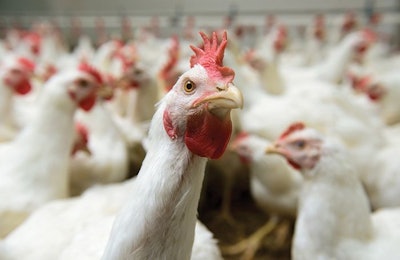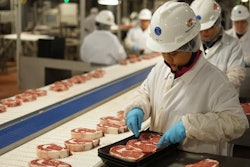
The African swine fever (ASF) devastating China’s swine herd and spreading around Southeast Asia and Eastern Europe will greatly change the global protein economy. The U.S. poultry industry looks to benefit from this bad situation, but it is unclear how long the gain will last.
The current situation with ASF
African swine fever, a highly contagious disease usually fatal for pigs with no vaccine or treatment options currently available, has spread throughout China at the cost of millions of pigs.
The outbreak first began there in August 2018, but the disease situation has since worsened. Although the Chinese government says the situation is under control, numerous observers disagree. ASF is now present in Taiwan, Vietnam and Cambodia, too.
China is the world’s leading producer of pork. Christine McCracken, a senior protein analyst covering North America for Rabobank’s RaboResearch Food & Agribusiness imprint, said the country typically slaughters more than 700 million hogs per year. Due to the disease outbreak, Rabobank expects production to drop by about 30% – or about 150 million to 200 million hogs – by the end of 2019.

Christine McCracken, Rabobank | Courtesy Rabobank
ASF is resilient. Past experience shows it can take years to stamp out. The virus can live for long periods in uncooked pork, for weeks in feces and for about a month in pig pens or transportation vehicles. McCracken said there’s no way to know long the outbreak will last in China and it will take years for the Chinese swine economy to fully recover. By comparison, an outbreak in Spain and Portugal, smaller countries with more developed swine farming, lasted for more than 30 years.
All told, Rabobank estimates ASF will cause a drop in the total, global protein supply of between 5 to 7% – or about 10 million metric tons – in 2019 alone. That deficit will have far ranging effects on the global economy.
How U.S. chicken will be impacted now
The gloomy situation in China is a ray of sunshine for global protein producers. China, which prefers pork, is the world’s most populous nation with a growing middle class hungry for meat.
Paul Aho, an economist and consultant with Poultry Perspective, said the prices of protein all over the world are going up in reaction to the ASF crisis in China. Additionally, the loss of hogs in China is lowering global demand for soy beans. However temporary, lower grain prices combined with higher meat prices will be a benefit for protein producers.
Specifically for chicken, Aho said this scenario is good even if the U.S. does not end up exporting any chicken to China. The U.S. industry is fortunate to be opening new poultry plants, and renovating existing facilities to increase production, just as the ASF outbreak is impacting the protein supply. Rather than contributing to an oversupply situation as was feared, Aho said the plants look perfectly timed and should be opening to high demand and favorable prices.
Ben Bienvenu, the managing director of Stephens Inc.’s food and agribusiness research sector, said the short term impacts may take a while to be seen. Chicken, and other protein prices, will rise more slowly than pork. From a stock market perspective, ASF only emerged on the scene in the past few months. However, the publicly traded companies involved in the chicken industry – Tyson Foods Inc., Pilgrim’s Pride Corp., Sanderson Farms Inc. – experienced rising stock prices as news of the severity of the ASF outbreak spread and as seasonal demand for chicken began to increase.

Ben Bienvenu, Stephens Inc. | Courtesy Stephens Inc.
Potential longer term impacts
Looking further into the future, it is harder to say how the U.S. chicken and turkey industries will be affected by the current outbreak of ASF. Generally, if there is a protein shortage in China it will mean more opportunities for other countries to fill the demand.
Bienvenu said it’s likely the ASF event will take years to be resolved. Even if the disease were totally eradicated overnight, it would take 20 months for China to get back to its pre-ASF production levels. Because of that, he expects chicken to benefit in terms of higher prices for the next several years.
Turkey will also likely benefit as consumers typically tradeoff between pork and turkey, particularly at the holidays. McCracken said whenever there is a shortage of ham on the market, turkey normally benefits. Lower supplies of competing protein on domestic markets should help alleviate oversupply issues in the turkey market, but it may not see the direct benefit of Chinese demand. Bienvenu agreed that ASF will be a positive demand driver for products like ground turkey meat and for turkey versus ham.
Will ASF force a trade deal between the U.S. and China?
The most significant question surrounding the financial impact of ASF on the U.S. poultry industry is whether or not the U.S. will be able to directly export products to China again. As of press time, there are on-going negotiations between the U.S. and China to establish a new trade deal between the world’s two largest economies.
Right now, no one can say with certainty that the ASF situation in China will force a deal. Nevertheless, the fundamentals of supply and demand suggest that the U.S. could gain some access to China for the first time in more than four years.
Jim Sumner, president of the USA Poultry & Egg Export Council, said China does not import frozen goods or breeding stock from the U.S. But, the dynamics of their own chicken industry and the country’s growing need for protein suggests the U.S.’ case for re-entering the market is gaining traction. He said as the year progresses and the meat supply situation becomes more desperate, China will be more encouraged to do something to fulfil demand. Nothing, he said, levels global trade quite like animal disease outbreaks.

Jim Sumner, USA Poultry & Egg Export Council | Courtesy USA Poultry & Egg Export Council
Sumner said negotiations are progressing between the U.S. and China and that chicken and turkey will be a very important part of the agricultural tenants of any deal. Moreover, the details of poultry trade are agreed upon. But, he said, there is no deal for agriculture until every part of a trade pact is completed.
Closure of any deal, Sumner said, will most likely come down to the leaders of both countries meeting and agreeing to terms personally. He said there are encouraging signs this could happen soon.
Future trade possibilities with China
If the U.S. does gain some access to China, it would be a further benefit for the poultry industry at large.
Whatever happens, China will import more chicken. If China does not end up importing anything from the U.S., and instead imports from Brazil and other exporters, Aho expects the U.S. market will still benefit because of higher prices. China historically imports jumbo paws and wing tips and could be a strong market for leg quarters, he said.
Before China’s 2010 ban on chicken imports on anti-dumping grounds, which preceded its current ban on avian influenza grounds imposed in 2015, the U.S. was exporting around 300,000 metric tons of chicken, or about 2 percent of its production, to China, Bienvenu said. If trade were to resume, it would likely be about the same amount of demand.
That raises the question if exporters can expect to set up shop for the long term in China due to new market access and favorable conditions spurred by the ASF crisis. Bienvenu said China is under high pressure to allow more imports due to rapidly inflating meat prices.
McCracken expects stronger export demand for U.S. chicken as global meat supplies tighten. However, she cautioned that U.S. exports of all protein could face logistical challenges. Right now, the necessary facilities – freezers, cold storage and containers – are potential bottlenecks that could limit exports. That can change, but investments will need to be made and it will take time.
While there is an opportunity for U.S. protein exporters, China aims to be self-sufficient in protein. McCracken expects China to move quickly to expand its poultry, seafood and egg industries. China's efforts to expand its chicken production will be slow due to an aging breeder flock and disease challenges. She expects the increase in Chinese poultry production to result in a long-term structural shift in demand that may permanently impair pork demand.


















